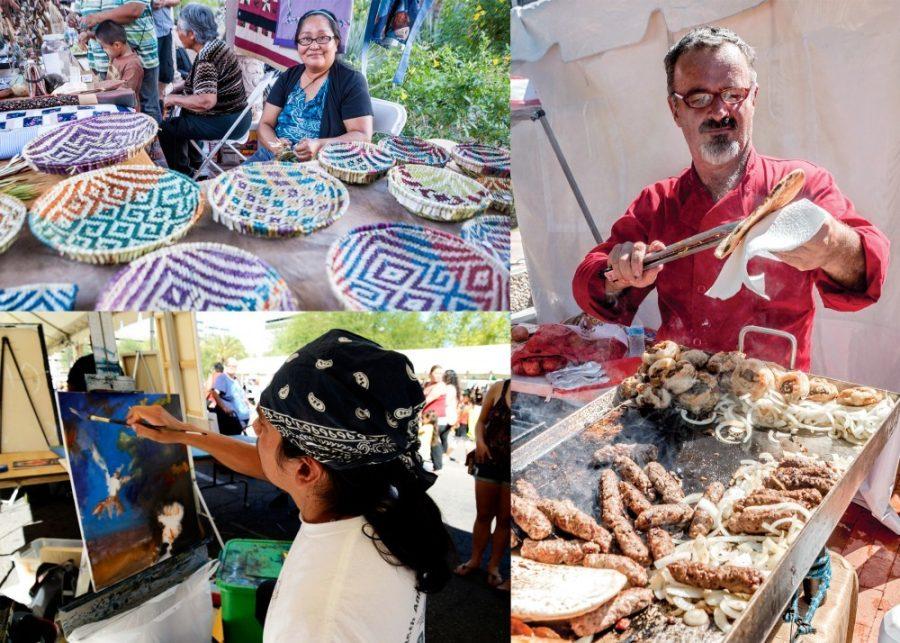Tucson is a beautiful place. Despite being in the dry, brown desert, various murals dot our cityscape. Sunsets with hues of red, orange, purple and blue fill the city sky and the valley that surrounds it with a rainbow of magnificent colors.
However, what defines the city’s beauty is not the sunsets, the mountains or even the murals on every corner, but the people. One of the most overlooked and under-celebrated features of life in Tucson is the diverse fabric of the population who make up the city and determine its inexplicably unique culture.
One hour north of the border between the United States and Mexico, you will find a city that has never lost its original and authentic Latinx identity. Mexican Americans, Hispanic Americans and Latinx Tucsonans make up 43.6% of the population and have left an incredible footprint making the city’s history. They fuel so much of the city’s politics and economy and create a large part of the city’s culture.
RELATED: CARES Act to keep Tucson’s small businesses running
Tucson is a United Nations Educational, Scientific and Cultural Organization designated creative city. It is also a city of gastronomy and its culinary geography is steeped in the cooking traditions of Sonora, a region that includes Southern Arizona and primarily Sonora, Mexico. Tucson was founded by a Hispanic Jesuit, Eusebio Francisco Kino, who is largely considered the father of Sonora. He found most of the territory of Sonora in the late 1600s and early 1700s which is speculated to be most of Tucson and most of Sonora, Mexico. Tucson is currently led by a Hispanic American mayor, Regina Romero. According to 2019 data from the Tucson Hispanic Chamber of Commerce, Hispanics in Tucson contribute close to $10 billion dollars annually to the local economy. Across the city, restaurants, businesses and people speak Spanish widely. Even the City of Tucson recognizes the language and the people as essential to the life of our city.
When we take appreciation for the people of Tucson, we cannot ignore the importance of Native American heritage and tradition to our community. Long before the days of Kino, Tucson and its surrounding areas were the traditional lands of the Tohono O’odham and Pascua Yaqui tribes. The University of Arizona and much of downtown Tucson was built overtime on stolen native lands.
Today, Indigenous and Native Americans play a seismic role in building and re-defining Tucson culture. UNESCO identified Tucson as a creative city and city of gastronomy largely for Indigenous traditions. One tradition is with the foods of the Tohono O’odham which are made from desert plants, like maize, tepary beans, Saguaro fruit and with dishes like the nation’s legendary frybread.
You can find no shortage of festivals celebrating the music, dance and traditions of the Pascua Yaqui and Tohono O’odham Nations, including January’s Mazo Kova Pahko Ceremony, February’s Sells Rodeo, March’s Wa:k Pow Wow and Thanksgiving celebrations at the San Xavier Market. Tucson’s wide linguistic landscape among Arabic, Greek and Spanish includes Pima, O’odham and Yaqui languages. As well, it is hard to ignore the huge economic benefit to Tucson’s tourist economy that Casino del Sol of the Pascua Yaqui Nation and the Desert Diamond of the Tohono O’odham Nation provide to the city and the entire region of Southern Arizona.
There is also a rich history and culture that surrounds the Black community of Tucson and Southern Arizona. Although only around 5.2% of the Tucson population, Black Tucsonans and Arizonans have held important roles in our region’s history. In the 1890s, Black Buffalo Soldiers came to the Tucson area. They protected our region by fighting valiantly in the Spanish-American War and safeguarding our city from the threats of the frontier.
Black Tucsonans are still looking for change. In 2020, Tucson was one of the few cities in Arizona that organized a series of powerful Black Lives Matter protests. As well, Tucson’s Juneteenth celebration has continued for over half a century, celebrating the liberation of Black Americans in all parts of the country, including Arizona. In our city’s artwork, you can also see monuments to Black Tucsonans around town, including one breathtaking mural painted by Robbie Lee Harris of a young Black girl on the side of Tucson’s Rialto Theater.
While the city did strike down in sanctuary status in 2019, it does have an impressive and diverse array of refugees who have come to Tucson from violence-stricken countries from all over the world. Tucson’s refugee population is in the thousands and many refugees from Africa, Asia and the Middle East are welcomed by inclusive programs. The programs include the Iskashitaa Refugee Network and the Refugee Ministry of Tucson, which work to make sure refugees who arrive in Tucson are cared for, supported and integrated fairly to life in the city.
The University of Arizona also has an incredibly diverse and wide international student community with 4,000 students coming from all corners of the globe. Students, domestic and international, are presented with the amazing opportunity to connect with each other and to mutually learn and benefit from a multicultural university experience. The UA’s International Friends organization is a network that provides resources for international students and enables domestic students to connect with those studying outside their home country.
Tucson’s wide array of languages, cultures and traditions is perhaps best exhibited during one of the city’s largest annual festivals: Tucson Meet Yourself. The festival is a one-stop place for everything Tucson, with a focus on the city’s vast and colorful patchwork of cultures. You can listen and watch traditional Folklorico music and dance from Mexico, eat fry bread from the O’odham ladies and savor the cultural cuisine of vendors showing off their specialty from all parts of the globe.
So the next time you see a vibrant Tucson sunset and feel grateful for the city you’re in, be sure to remember the colorful community of people in it.
Follow Ian Tisdale on Twitter









